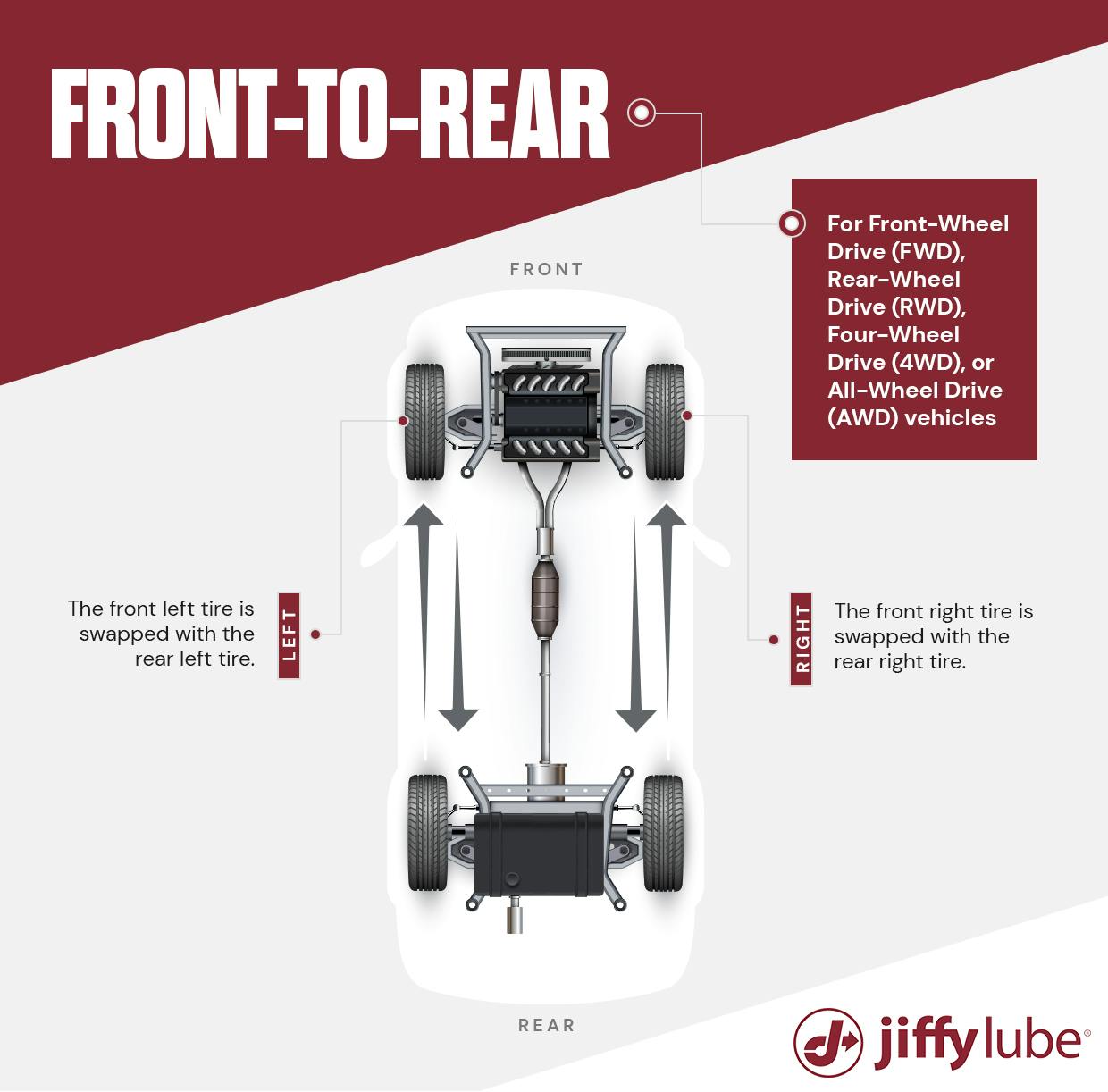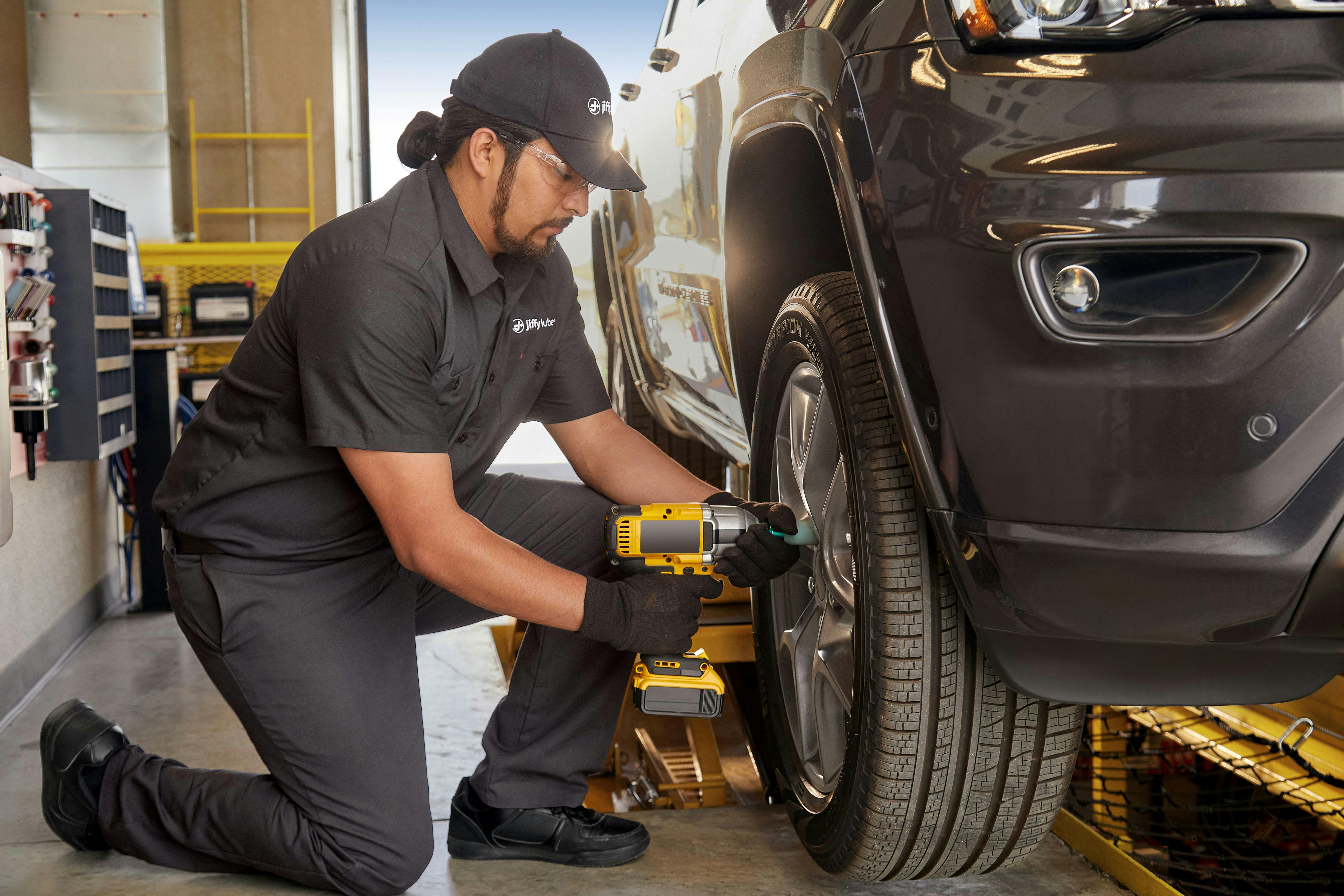A tire rotation is one of the simplest ways to keep your vehicle running at its best. But do you know what exactly goes into a tire rotation and why it's so important? In this article, we’ll answer these questions, dive into the different tire rotation patterns, and review a few considerations when getting a tire rotation.
What Is a Tire Rotation and Why Is It Important?
A tire rotation simply means moving each tire to another position on your vehicle. Tire rotations are necessary because the vehicle’s weight isn’t distributed evenly to all four tires, so they wear differently depending on their location. For example, the front tires on most vehicles tend to wear out quicker than the rear tires because they bear more torque and friction for turning, accelerating, and braking. By regularly rotating your tires, you help extend the life of your tire treads, prevent uneven tire wear, and avoid losing tire traction.
Another benefit of regular tire rotations is that they allow your tires to wear more evenly, thus enabling you to replace all your tires simultaneously rather than individually or in pairs. This helps maintain handling continuity and allows you to take advantage of the latest tire technology instead of matching a pair of older tires.
A tire rotation is also a good opportunity to ensure that your wheels are balanced. Unbalanced wheels can cause rapid tire wear because the tires may not be making consistent contact with the road, meaning you may have to replace your tires more often (that’s a lot of money!) In addition to wheel balancing, a vehicle alignment can help promote even tire wear and keep your car on the straight and narrow.
You might wonder: How often should I rotate my tires? Most tire manufacturers recommend rotating your tires every 5,000 to 8,000 miles but refer to your owner's manual to get specific information for your vehicle.
Tire Rotation Patterns
The tire rotation pattern that’s best for your vehicle depends on several factors, including:
- Manufacturer’s guidelines
- The type of tire
- Your vehicle’s drive type — Front-Wheel Drive (FWD), Rear-Wheel Drive (RWD), Four-Wheel Drive (4WD), or All-Wheel Drive (AWD)
- Whether your tires are directional or nondirectional
- Whether or not your vehicle’s front and rear tires are the same size
However, the standard operation for most automotive professionals is the front-to-rear pattern.
Front-to-Rear
All tires are moved from one axle to the other but remain on the same side. For example, the front right tire is swapped with the rear right tire, and the front left tire is swapped with the rear left tire.
Other Tire Rotation Patterns
There may be instances where the standard method is not suitable for your car. Here are three other tire rotation patterns that may be used.
Rearward Cross
The rearward cross method features two different patterns depending on the scenario.
- .For RWD, 4WD, or AWD vehicles with nondirectional tires of uniform size: The rear tires move directly to the front axle, staying on the same side of the vehicle. The front tires move diagonally to opposite sides of the rear axle.
- For RWD or 4WD vehicles with nondirectional tires of uniform size and a full-size spare: The rear tires move to the front axle and stay on the same side, while the spare tire moves to the right side of the rear axle. The right front tire moves diagonally back to the left side of the rear axle, and the front left tire becomes the new spare.
Forward Cross
The forward cross method also has two different tire rotation patterns depending on the situation.
- For FWD vehicles with nondirectional tires of uniform size: The front tires move directly back to the rear axle, staying on the same side of the vehicle. The rear tires move diagonally to the opposite sides of the front axle.
- For FWD vehicles with nondirectional tires of uniform size and a full-size spare: The rear tires move diagonally to the opposite sides of the front axle. The spare tire moves to the right side of the rear axle while the front left tire moves directly back to the left rear position. The right front tire becomes the new spare tire.
X-Pattern
The X-pattern is another method used for FWD vehicles.
- For FWD vehicles with nondirectional tires of uniform size: All tires move diagonally, meaning the rear left tire swaps positions with the front right tire, and the right rear tire trades places with the front left tire.
Tire Rotation Considerations
If you have a high-performance vehicle, the front and rear axles may have differently sized tires, so your tires cannot be rotated utilizing the standard operation. Instead, tires must be rotated from side to side, meaning the front tires switch positions with each other, and the rear tires do the same.
Additionally, some vehicles require you to reprogram the Tire Pressure Monitoring System (TPMS) after a tire rotation. This helps ensure that the TPMS accurately monitors the tire pressure for each wheel's new position, maintaining your vehicle’s safety and performance. For all Jiffy Lube® tire rotation services, a trained technician will reprogram the TPMS if necessary.

Visit Your Local Jiffy Lube for Tire Rotation Services
Tire rotations are essential to tire maintenance, and you can count on your local Jiffy Lube to keep your wheels rolling smoothly. Trained technicians rotate your tires utilizing the standard operation, but if you request otherwise, they will be more than happy to accommodate your needs. They can also provide a tire rotation schedule for your vehicle so you can have peace of mind knowing your tires will be ready for the road ahead.
NOTE: Not all services are offered at all Jiffy Lube service centers. Please call ahead or check jiffylube.com to ensure the service is available at the Jiffy Lube location near you.
